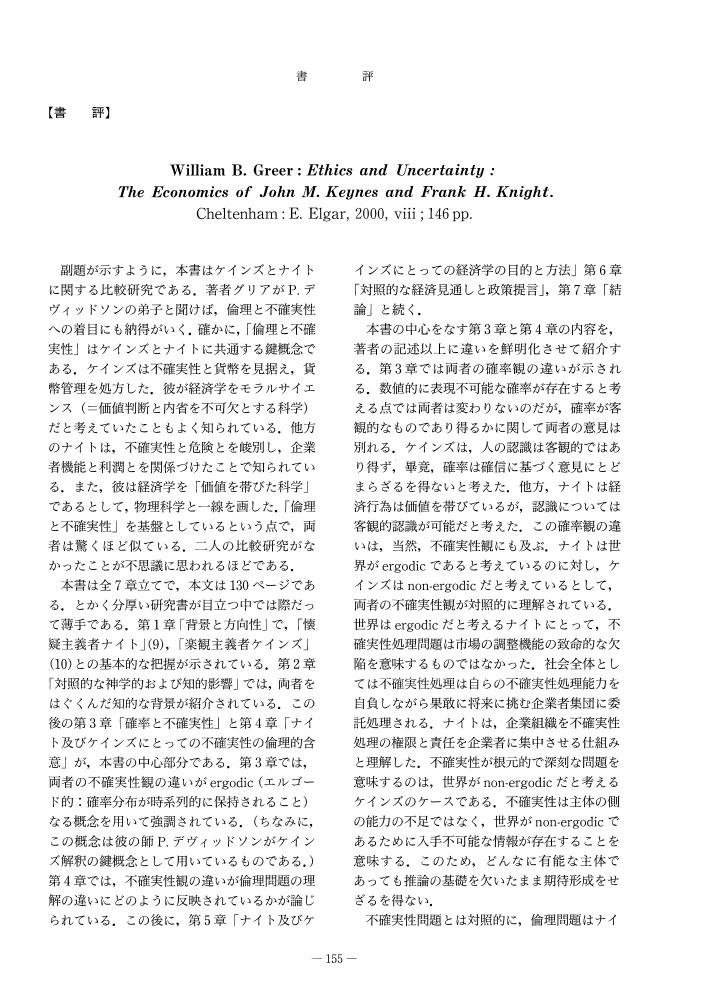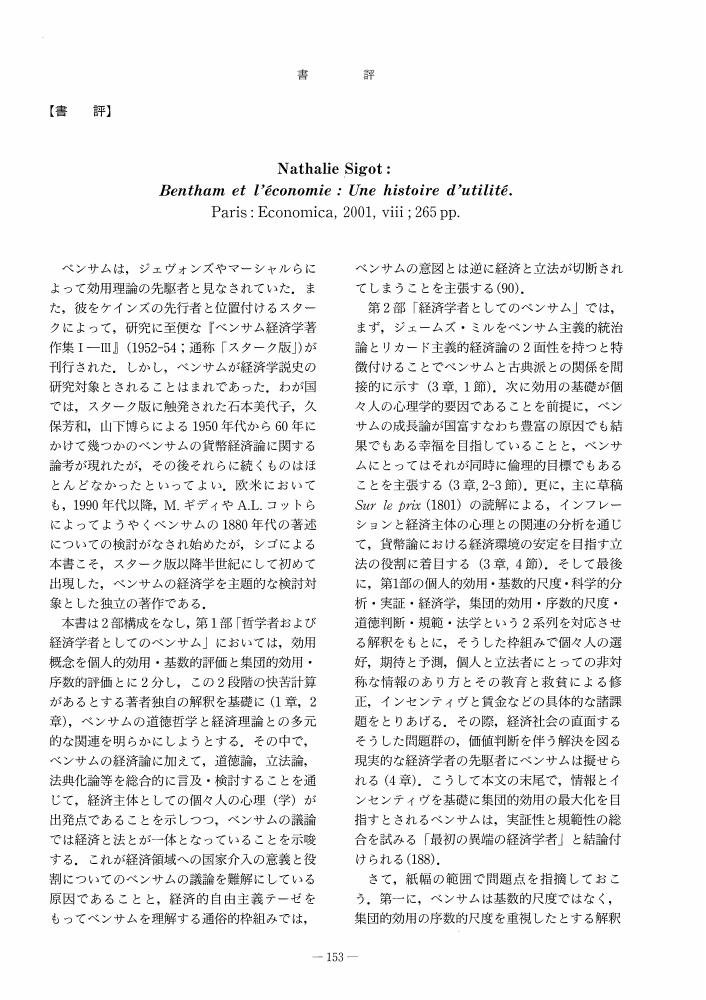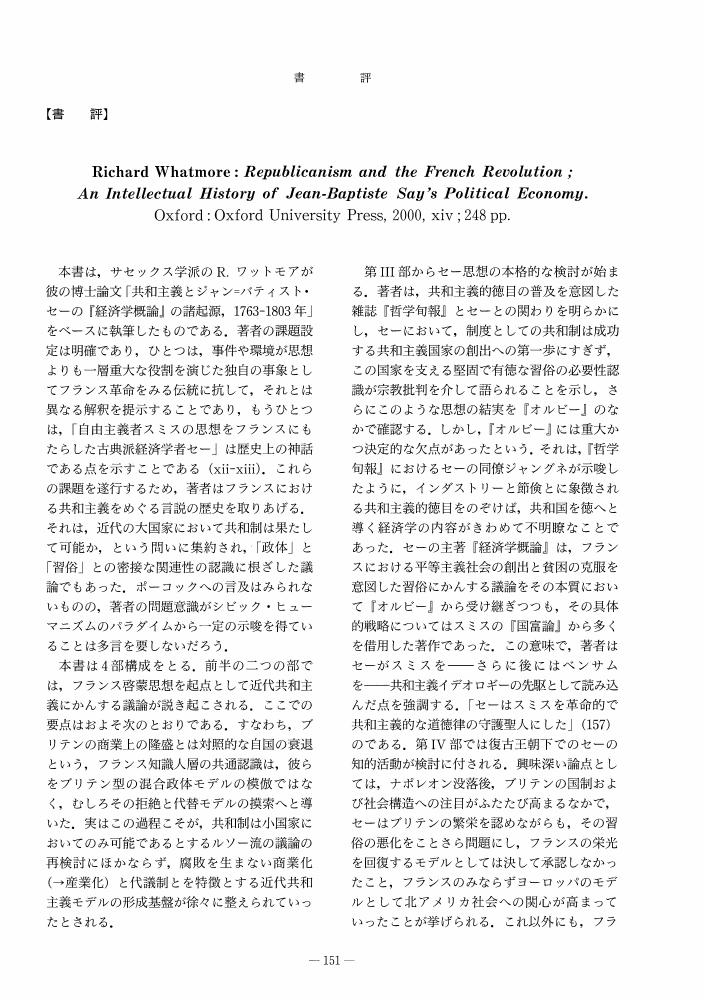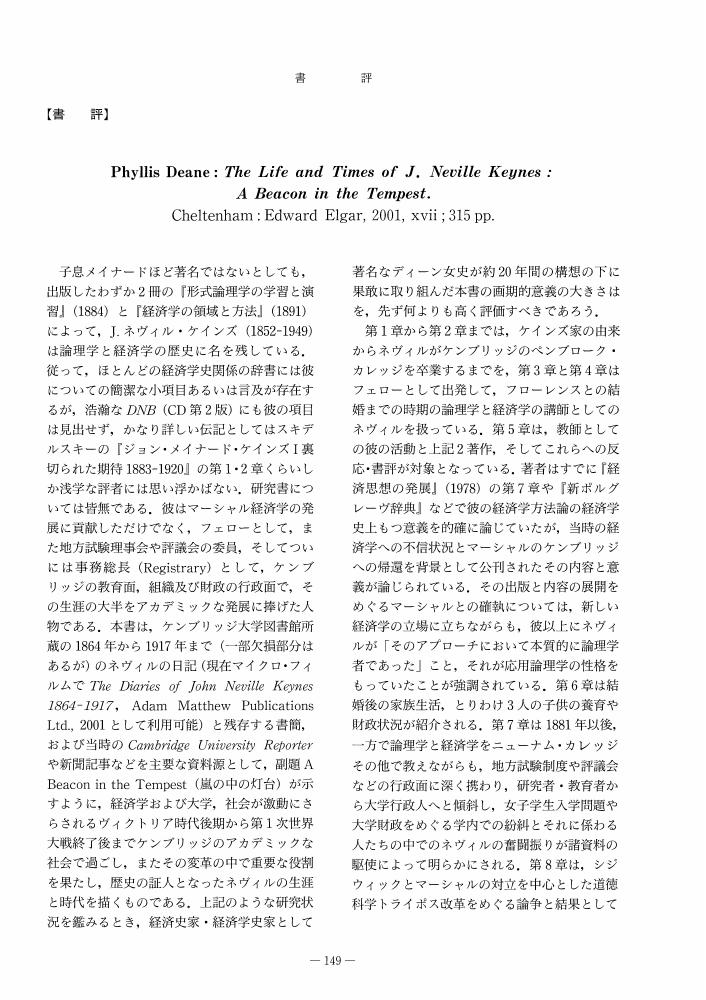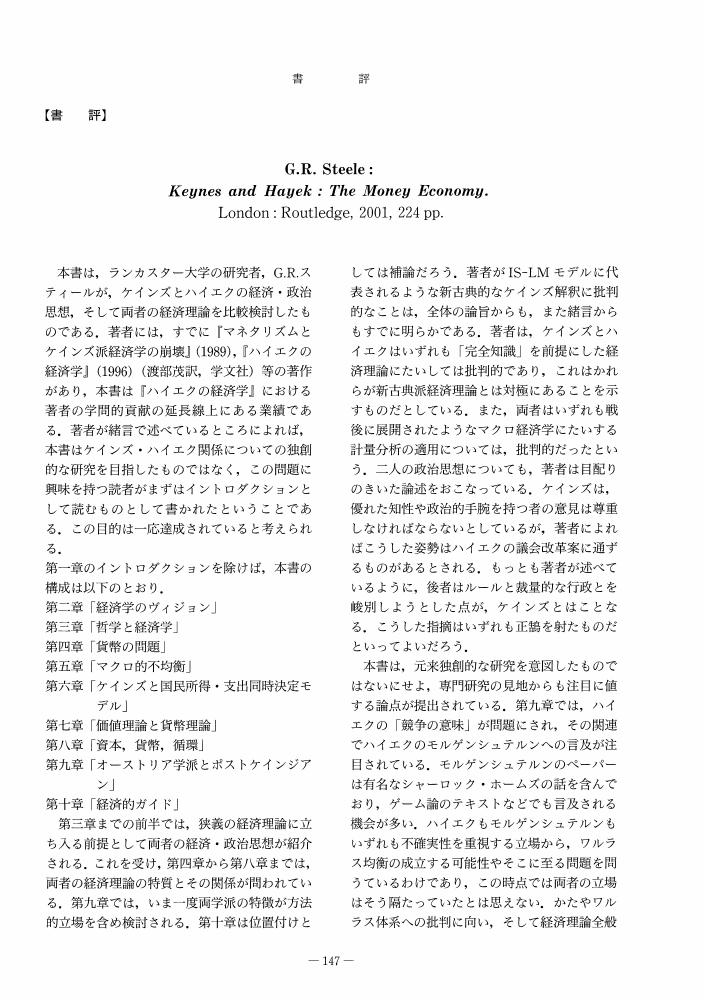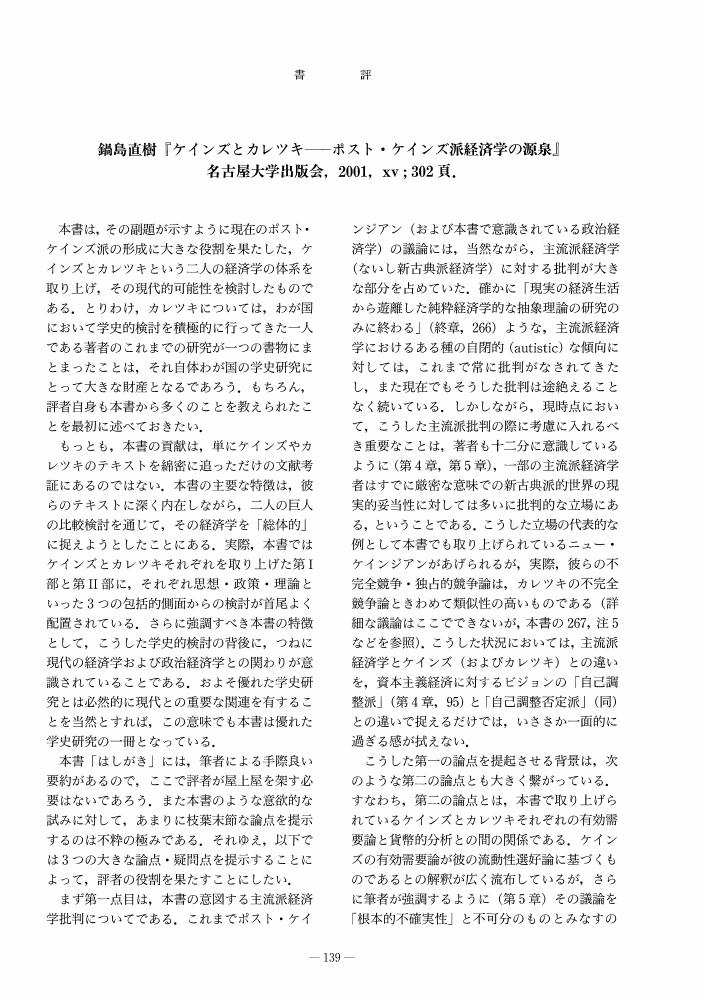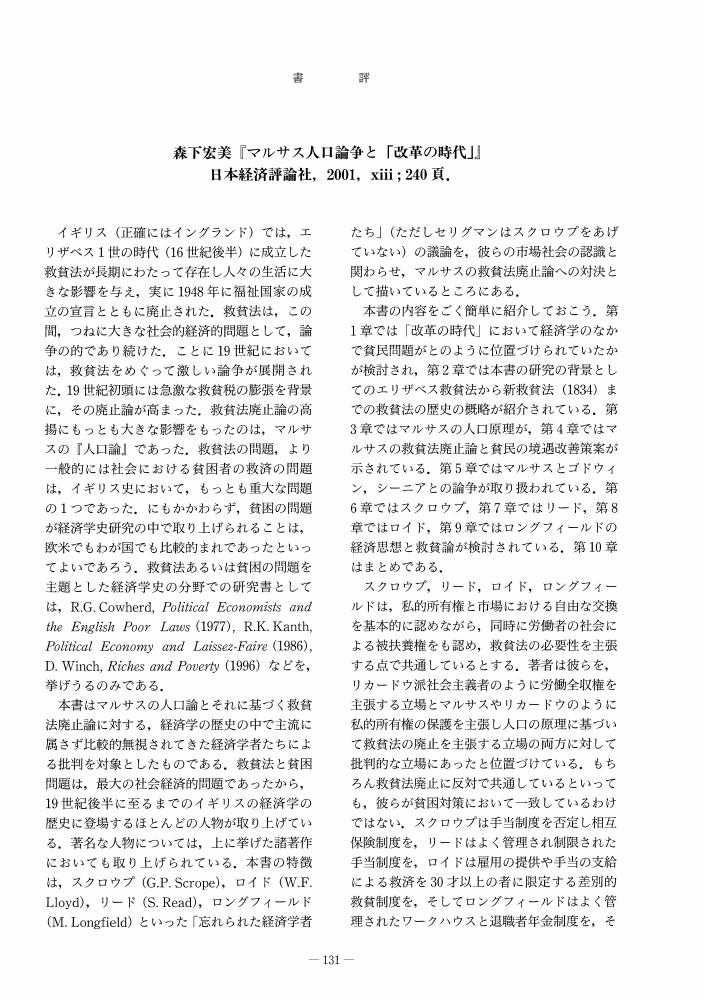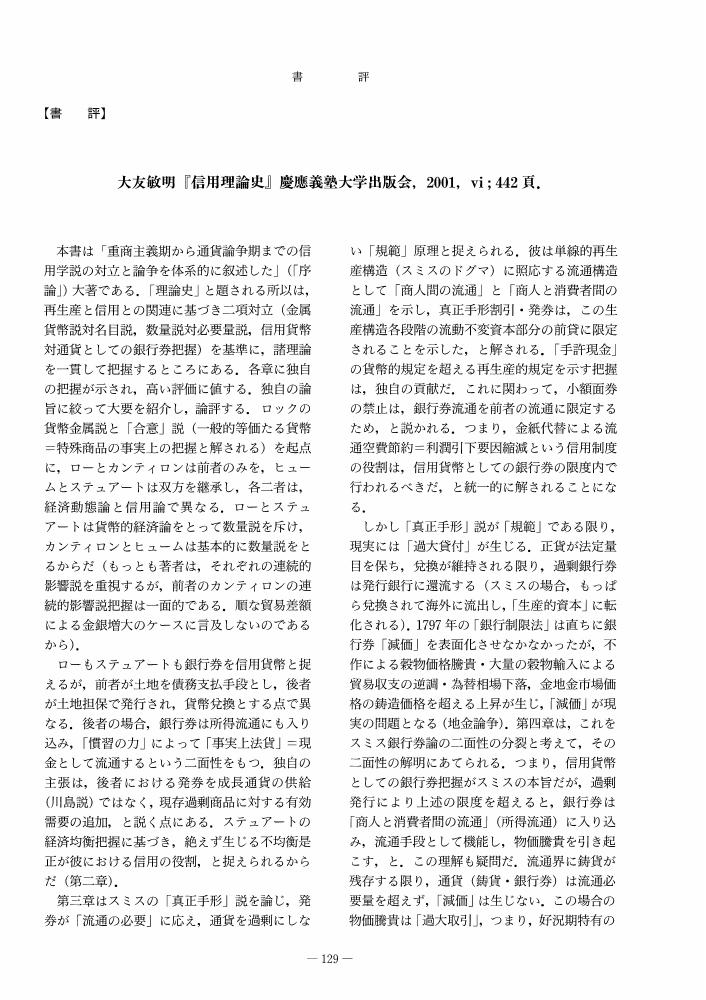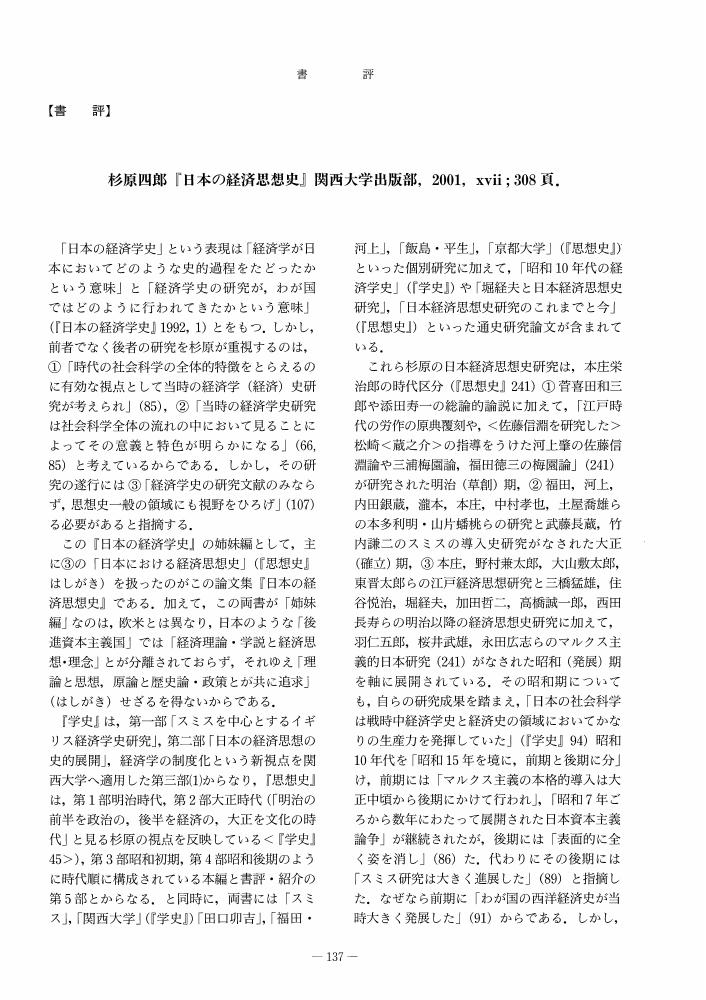- 著者
- 高橋 和男
- 出版者
- The Japanese Society for the History of Economic Thought
- 雑誌
- 経済学史学会年報 (ISSN:04534786)
- 巻号頁・発行日
- vol.42, no.42, pp.157-158, 2002 (Released:2010-08-05)
- 著者
- 藤井 賢治
- 出版者
- The Japanese Society for the History of Economic Thought
- 雑誌
- 経済学史学会年報 (ISSN:04534786)
- 巻号頁・発行日
- vol.42, no.42, pp.155-156, 2002 (Released:2010-08-05)
1 0 0 0 OA Nathalie Sigot: Bentham et l'économie: Une histoire d'utilité. Paris: Economica, 2001, viii; 265pp.
- 著者
- 有江 大介
- 出版者
- The Japanese Society for the History of Economic Thought
- 雑誌
- 経済学史学会年報 (ISSN:04534786)
- 巻号頁・発行日
- vol.42, no.42, pp.153-154, 2002 (Released:2010-08-05)
- 著者
- 高橋 信勝
- 出版者
- The Japanese Society for the History of Economic Thought
- 雑誌
- 経済学史学会年報 (ISSN:04534786)
- 巻号頁・発行日
- vol.42, no.42, pp.151-152, 2002 (Released:2010-08-05)
- 著者
- 上宮 正一郎
- 出版者
- The Japanese Society for the History of Economic Thought
- 雑誌
- 経済学史学会年報 (ISSN:04534786)
- 巻号頁・発行日
- vol.42, no.42, pp.149-150, 2002 (Released:2010-08-05)
- 著者
- 池田 幸弘
- 出版者
- The Japanese Society for the History of Economic Thought
- 雑誌
- 経済学史学会年報 (ISSN:04534786)
- 巻号頁・発行日
- vol.42, no.42, pp.147-148, 2002 (Released:2010-08-05)
- 著者
- 下平 裕之
- 出版者
- The Japanese Society for the History of Economic Thought
- 雑誌
- 経済学史学会年報 (ISSN:04534786)
- 巻号頁・発行日
- vol.42, no.42, pp.159-160, 2002 (Released:2010-08-05)
- 著者
- 安藤 隆穂
- 出版者
- The Japanese Society for the History of Economic Thought
- 雑誌
- 経済学史学会年報 (ISSN:04534786)
- 巻号頁・発行日
- vol.42, no.42, pp.161-162, 2002 (Released:2010-08-05)
- 著者
- 中澤 信彦
- 出版者
- The Japanese Society for the History of Economic Thought
- 雑誌
- 経済学史学会年報 (ISSN:04534786)
- 巻号頁・発行日
- vol.42, no.42, pp.163-164, 2002 (Released:2010-08-05)
- 著者
- 池田 毅
- 出版者
- 経済学史学会
- 雑誌
- 経済学史学会年報 (ISSN:04534786)
- 巻号頁・発行日
- vol.42, no.42, pp.139-140, 2002 (Released:2010-08-05)
- 著者
- 野口 旭
- 出版者
- The Japanese Society for the History of Economic Thought
- 雑誌
- 経済学史学会年報 (ISSN:04534786)
- 巻号頁・発行日
- vol.42, no.42, pp.141-142, 2002 (Released:2010-08-05)
- 著者
- 竹永 進
- 出版者
- The Japanese Society for the History of Economic Thought
- 雑誌
- 経済学史学会年報 (ISSN:04534786)
- 巻号頁・発行日
- vol.42, no.42, pp.143-146, 2002 (Released:2010-08-05)
1 0 0 0 OA 小林昇『経済学史春秋』未来社, 2001, x; 209頁
- 著者
- 水田 洋
- 出版者
- 経済学史学会
- 雑誌
- 経済学史学会年報 (ISSN:04534786)
- 巻号頁・発行日
- vol.42, no.42, pp.135-136, 2002 (Released:2010-08-05)
- 著者
- 内田 弘
- 出版者
- 経済学史学会
- 雑誌
- 経済学史学会年報 (ISSN:04534786)
- 巻号頁・発行日
- vol.42, no.42, pp.133-134, 2002 (Released:2010-08-05)
- 著者
- 渡会 勝義
- 出版者
- 経済学史学会
- 雑誌
- 経済学史学会年報 (ISSN:04534786)
- 巻号頁・発行日
- vol.42, no.42, pp.131-132, 2002 (Released:2010-08-05)
1 0 0 0 OA 大友敏明『信用理論史』慶應義塾大学出版会, 2001, vi; 442頁
- 著者
- 中村 廣治
- 出版者
- 経済学史学会
- 雑誌
- 経済学史学会年報 (ISSN:04534786)
- 巻号頁・発行日
- vol.42, no.42, pp.129-130, 2002 (Released:2010-08-05)
1 0 0 0 OA 杉原四郎『日本の経済思想史』関西大学出版部, 2001, xvii; 308頁
- 著者
- 井上 琢智
- 出版者
- 経済学史学会
- 雑誌
- 経済学史学会年報 (ISSN:04534786)
- 巻号頁・発行日
- vol.42, no.42, pp.137-138, 2002 (Released:2010-08-05)
1 0 0 0 OA 機械と身体
- 著者
- 長尾 伸一
- 出版者
- The Japanese Society for the History of Economic Thought
- 雑誌
- 経済学史学会年報 (ISSN:04534786)
- 巻号頁・発行日
- vol.42, no.42, pp.106-117, 2002 (Released:2010-08-05)
- 参考文献数
- 60
It has often been said that Adam Smith adapted his idea of the mechanism of the self-regulating market from physics. The regulating principle of natural price in his theory has the same explanatory role as the concept of gravitation has in Newtonian system. This view has been reinforced by the fact that young Smith wrote a serious study on the history of astronomy and, based on his methodological viewpoint, discussed the development of the science from the ancient to Newton. Contrary to this familiar notion however, he employed two kinds of metaphor in The Wealth of Nations, the one is of the machine, and the other is of the human body. Recent years have seen renewed interest in nature, and the function of metaphor has been seen in various domains of science and philosophy. The studies based on the method of cognitive sciences, especially of cognitive linguistics, are worth mentioning among the literature treating the subject, for they have persuasively demonstrated that metaphor must have been regarded not only as a form of figurative statement but also as an indispensable tool of the human cognitive process. Smith's usage of scientific metaphor in The Wealth of Nations could be well interpreted from this point of view. It has been observed in the literature on metaphor that the employment of metaphor endowed political discourse with persuasive power. It also has effectively been argued that metaphor was essential in a creative cognitive process in the way that it helped to reveal the unknown order of the subject of investigation, though it is still not certain that which of the explanations of its function, suggested by scholars in several different ways, is really working in the process.Smith and Steuart seemed to agree that the machine was the adequate symbol of both the natural and political entity created by God. Explaining the property of the political body that attracted people's attention, Adam Smith frequently used the word “machine.” This symbolism seems to have been intended to represent visually the perfection of the complex mechanism of political institutions. James Steuart adopted this symbolism on several occasions. Along with the metaphor of machine, though, the image of the “body natural”, the human body, has played an important role in economic literature, representing the order of the economic system. Medicine provided metaphor, in a comparison of society to the human body, to the pioneers of economics, such as William Petty, Nicholas Barbon, John Locke, and François Quesnay, who were physicians as well. The metaphors depending on anatomy, circulation, reproduction, harmony, balance, symmetry, and the equilibrium of elements which constitute the natural body, the self-healing power of organism, etc., have been continuously employed in the history of economics up to the present by many economists, including Josiah Tucker and Adam Smith himself, who were not physicians. Thus, both metaphors contributed to the development of economic science and probably increased the persuasive power of economic writings at the same time.
1 0 0 0 OA 官房学研究とゼッケンドルフ
- 著者
- 川又 祐
- 出版者
- The Japanese Society for the History of Economic Thought
- 雑誌
- 経済学史学会年報 (ISSN:04534786)
- 巻号頁・発行日
- vol.42, no.42, pp.84-94, 2002 (Released:2010-08-05)
- 参考文献数
- 41
Germany from the 16th to early 19th century was mostly influenced by cameralism. Generally speaking, cameralism has a broad and narrow sense, and two periods (before and after 1727). Cameralism is called a variant of mercantilism in Germany. This can be considered accurate if we interpret mercantilism in a wider sense. But first these definitions must be verified from various points of view.Roscher was the first authority on cameralism. Roscher included cameralism among the category of economics. Criticizing Roscher, Small says, “cameralism was not a theory and practice of economics but of politics. Cameralism was a technique and a theory of administering a peculiar type of state in a society constructed out of peculiar types of purposes (Small 1909, 3).” Before and after Small, Marchet, Stieda, Nielsen, Zielenziger, Sommer, Tautcher, and Tribe have made their respective interpretations. Marchet's point of view is from that of public administration, while Stieda's is from the history of the university at which a chair for cameralism had been founded in 1727. Nielsen comes from the aristotelianism, Zielenziger and Sommer come from German and Austrian mercantilism, Tautscher comes from public finance, while Tribe comes from the instituted ‘cameralism as science’ at German universities. The subject of Tribe's cameralistic study is after 1727. Their main issues were whether or not cameralism is mercantilism, and whether or not cameralism is a science (such as economics or politics). Their interpretations may differ from each other's.We can regard Seckendorff as a representative of old and new cameralists. He served at the court of Herzog Ernst in Gotha. What underlies his main book Teutscher Fürstenstat is his great deal of experience at Gotha. He wrote the book making use of his own practical experience and finally became a model cameralist; Small said that Seckendorff was the Adam Smith of cameralism (Small 1909, 69). Seckendorff's thought has been divided and refined into various branches by new cameralists (Gasser, Dithmar, Justi and Sonnenfels etc.), that is, economic science, the science of Polizei (the future public administration), and cameralism (the future public finance). Therefore, Seckendorff must be the center of attention in cameralistic study. Accordingly, our starting point is Seckendorff and his Teutscher Fürstenstat. The distinction between what new cameralists accepted from Seckendorff and what they didn't accept from him should be made clearly. This distinction can be held to characterize cameralism and at the same time determine cameralism's scope and limits.Recently, students of early modern German history have rendered great service to our learned society. For example, Brunner, Oestreich, and Stolleis have revealed to us that absolute princes in those days had not always unlimited powers. It is necessary for us to trace once more the history of cameralism, paying more attention to the important results of historian research. A strong knowledge of the German condition in those days (state, government, religion, industry, concepts of ‘happiness, welfare, Polizei and Regalien, ’ and so on) is required for a comprehensive understanding of cameralism.We have made sure and steady progress in our study of cameralism. But we should endeavor to obtain an authentic image of cameralism, adding many case and area studies to the study of cameralist literature.
1 0 0 0 OA ヴェブレンとナイトの企業者論
- 著者
- 黒木 亮
- 出版者
- The Japanese Society for the History of Economic Thought
- 雑誌
- 経済学史学会年報 (ISSN:04534786)
- 巻号頁・発行日
- vol.42, no.42, pp.71-83, 2002 (Released:2010-08-05)
- 参考文献数
- 49
In The Theory of Business Enterprise (1904), T. B. Veblen pointed out that the modern entrepreneurs had not performed the classical role of coordinator in allocating resources, nor were they innovators, but had became Captains of Industry by conducting endless mergers and acquisitions in order to increase the value of their concern's capital. This new entrepreneurial activity, however, has essentially a “confidence game” character, it is not always connected with industrial serviceability. Even if he wins in “pecuniary” competition by superior marketing strategy, it doesn't necessarily follow “real” success. Conversely, he may sabotage the improvement of productivity by price-production control or collusion with the others, in case their asset value decrease. This is the reason why Veblen called them “parasites” of industrial society, and extended the theory of “chronic depression” that businessmen who lamented a desirable situation that social welfare in real-terms was rapidly growing looked as if they had suffered “a malady of the affection.” Veblen therefore expected that such entrepreneurs and their functions would fade way, and would finally be replaced by a “technocracy” in the far future.In Risk, Uncertainty and Profit (1921), F. H. Knight insisted that an entrepreneur was the core of system of Big Business that had made possible not only the centralization of control, but also the diffusion of investment. In such a highly organized society, “moral hazard” or the principal-agent problem might not have been avoidable, so his special role was the selection of men: selecting some agents among specialists, assuring their fixed salary, and taking responsibility regardless of their results. To such decision-making and risk-taking activity Knight imputed profits, and concluded that the average profit was probably minus, or that the net result of the whole business activity might suffer loss. Nevertheless he also observed that business game would be continued by bold entrepreneurs having “confidence” in their ability or “luck, ” so that free enterprise should never fade way.In sum, Veblen emphasized the scheme of so called Business vs. Industry and an entrepreneur's parasitic position. While Knight made allowance for the irrational character of the business game as Veblen, he also shed light on the humane aspect of entrepreneurship and its universality. In other words, their points of view were very close, and both revealed the crucial defects of the Big Business society, although their predictions for the future were divergent. Veblen and Knight stand back to back with each other.

